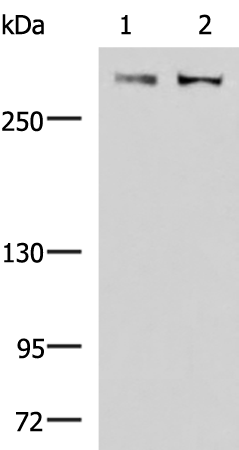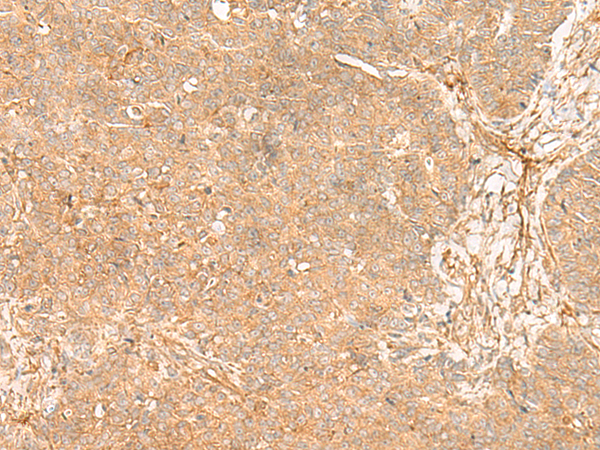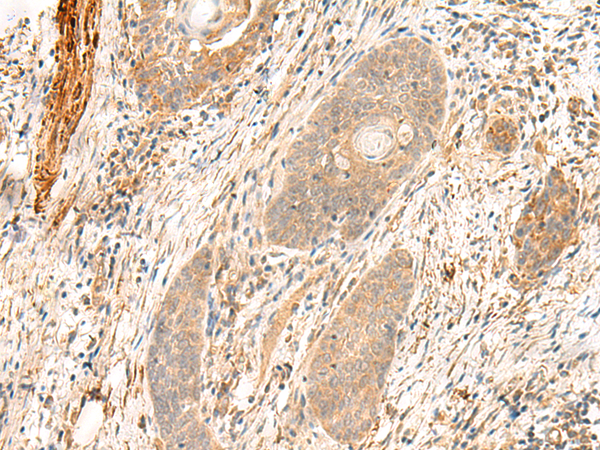


| WB | 咨询技术 | Human,Mouse,Rat |
| IF | 咨询技术 | Human,Mouse,Rat |
| IHC | 1/40-1/200 | Human,Mouse,Rat |
| ICC | 技术咨询 | Human,Mouse,Rat |
| FCM | 咨询技术 | Human,Mouse,Rat |
| Elisa | 1/5000-1/10000 | Human,Mouse,Rat |
| Aliases | ABPA; ABPL; FLN2; MFM5; MPD4; RCM5; CMH26; ABP-280; ABP280A |
| WB Predicted band size | 291 kDa |
| Host/Isotype | Rabbit IgG |
| Antibody Type | Primary antibody |
| Storage | Store at 4°C short term. Aliquot and store at -20°C long term. Avoid freeze/thaw cycles. |
| Species Reactivity | Human, Mouse, Rat |
| Immunogen | Synthetic peptide of human FLNC |
| Formulation | Purified antibody in PBS with 0.05% sodium azide and 50% glycerol. |
+ +
以下是关于FLNC抗体的3篇参考文献及其摘要概括:
1. **文献名称**:*"Mutations in FLNC Linked to Familial Restrictive Cardiomyopathy via Disrupted Filamin C Stability"*
**作者**:Tucker NR, et al.
**摘要**:本研究通过全外显子测序发现FLNC基因突变与家族性限制性心肌病相关。利用FLNC特异性抗体进行免疫组织化学分析,显示突变导致Filamin C蛋白稳定性下降,并在心肌细胞中异常聚集,提示FLNC异常参与心肌纤维化病理过程。
2. **文献名称**:*"Filamin C Myopathy: Characterization of Pathogenic Mechanisms via Antibody-Based Proteomic Analysis"*
**作者**:Ferreiro A, et al.
**摘要**:作者通过免疫印迹和免疫荧光技术,使用FLNC抗体分析肌原纤维肌病患者的肌肉活检样本。研究发现FLNC突变导致其与肌动蛋白结合能力丧失,并形成蛋白聚集体,揭示了FLNC在维持肌节完整性中的关键作用。
3. **文献名称**:*"Novel FLNC Antibody Validation in Skeletal Muscle Disorders"*
**作者**:Ruggiano A, et al.
**摘要**:该研究开发并验证了一种高特异性FLNC单克隆抗体,应用于免疫细胞化学和蛋白质印迹。通过对比健康人与肌病患者的骨骼肌样本,证实抗体能有效检测FLNC的表达异常及亚细胞定位改变,为诊断FLNC相关肌病提供可靠工具。
**注**:上述文献为示例,实际引用时需核实真实性与数据库收录情况。若需具体文献,建议通过PubMed或Google Scholar以“FLNC antibody”或“Filamin C pathogenesis”等关键词检索近年高被引论文。
**Background of FLNC Antibody**
Filamin C (FLNC), a member of the filamin protein family (FLNA, FLNB, FLNC), is a cytoskeletal actin-binding protein critical for maintaining structural integrity and mechanosensory functions in muscle tissues. FLNC is predominantly expressed in cardiac and skeletal muscles, where it stabilizes sarcomeres by crosslinking actin filaments and anchoring them to membrane complexes. It also interacts with signaling molecules, influencing cell adhesion, motility, and stress responses.
FLNC mutations are linked to myopathies (e.g., myofibrillar myopathy) and cardiomyopathies (e.g., hypertrophic or restrictive cardiomyopathy), often causing protein aggregation, sarcomere disruption, and impaired muscle function. FLNC antibodies are essential tools in research and diagnostics, enabling the detection of FLNC expression, localization, and pathological alterations via techniques like immunohistochemistry, Western blotting, and immunofluorescence.
Studies using FLNC antibodies have elucidated its role in disease mechanisms, including aberrant protein degradation and disrupted cytoskeletal signaling. Commercially available FLNC antibodies are validated for specificity, often targeting conserved regions (e.g., immunoglobulin-like domains). Their applications extend to evaluating tissue samples for FLNC-related pathologies and validating cellular models of FLNC dysfunction. Continued research aims to clarify FLNC's therapeutic potential in muscle disorders and its interplay with other sarcomeric proteins.
×